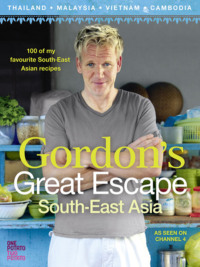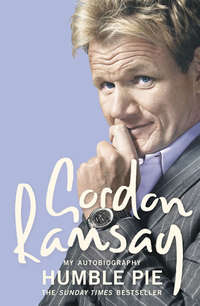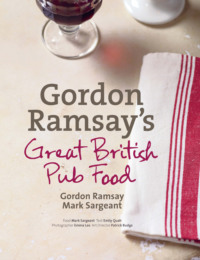
Полная версия
Gordon Ramsay’s Playing with Fire
It was such a nightmare that I nearly missed the men in grey agreeing to Chris’s revised figure. Their suggested £1,500 fee was big wonga, and not only had Chris saved it, but he had also shown me that bankers really can be wankers. The exception was Iain, who, I could see, had a sardonic smile on his face for much of this ‘delicate’ negotiating. He knew that what we were setting out to do was just the beginning of bigger stuff to come, and he was instrumental in these first, tentative steps.
Suddenly, the meeting was at an end, and there was this short-arsed, gritty Scot with a sharp eye and tongue smiling, shaking hands and wishing us well. Fuck. Easy as that.
But, of course, it wasn’t quite so. It’s one thing to borrow the money, but then you have to pay it back – with interest. Also, just as we were getting the loan agreed, there were things happening that would later have a big effect on my business. But at the time I didn’t know that, and it just seemed to be threatening my deal. In fact, there seemed no solution. What had happened was that the Savoy Group had been approached by what was then an almost unknown financial animal called ‘private equity’.
Private equity has become controversial for a number of reasons, and it is a familiar phrase today. It means powerful investment funds not available to the general public or traded on stock exchanges, which buy up companies in return for a share in the ownership. In this case, Blackstone Private Equity were the Savoy Group’s suitors, and it was the first time that I ever heard the name that would become so important to us. On this occasion, they were offering over half a billion pounds to shareholders of the Savoy Group to buy Claridge’s, The Connaught, The Berkeley and, of course, The Savoy.
Once this deal had gone through, the idea was that these private equity players would bring about changes to increase the value of the Savoy Group in order to make it saleable at a profit acceptable to their investors. The trouble was that it meant that everything to do with the Savoy Group was on hold while the deal was going on, and that included Pierre Koffmann’s move, too – which, in turn, meant ours. Before we knew it, we were back on the streets looking for alternative premises. We searched and looked at half a dozen sites, and each new potential restaurant we saw made us realize that Royal Hospital Road was, by far, what we wanted most. It was heart breaking to accept that it just wasn’t going to happen.
Months went by. Updates on the Blackstone front were hard to come by. Their deal had eventually gone through, and they were now busy thinking about a million different changes they wanted to make in the way the Savoy Group was run. Whether they wanted Pierre Koffmann or not was just one of the decisions that they would make in the fullness of time, and we just had to wait. Pierre’s advisors had long ago stopped returning calls, and I could feel the deal going cold.
One of these advisors was a particularly irritating ‘fixer’, a slobby suit who had clearly eaten well and frequently at La Tante Claire. Perhaps he sensed that this cosy arrangement was coming to an end and, as it became clear that Pierre’s deal with The Berkeley actually might happen after all, Slobby became more elusive. Luckily for us, there was a lively partner from Pierre’s accountancy firm who grabbed the ball and ran with it. Without him, I think we would still be on the touchline.
The deal progressed, and suddenly, there we were in the offices of the lawyers who were acting for La Tante Claire with a mile-long paper trail of agreements, leases, indemnities and guarantees ready for Chris and me to sign. As the snowstorm came to a finish, the lawyers wheeled in lunch and champagne to mark this momentous occasion. In all the completion meetings that took place later – and there were a lot of them – this was the one I’ll always remember. Not just because it was the first, but because of this small gesture of kinship and kindness.
The bank had sent down a lesser minion to make sure the right signatures were attached to the borrowings documents. He was last to leave, having drunk enough bubbly to match what he considered an onerous task.
It was, without doubt, a fucking relief. I could now be open about my plans. I could leave Aubergine and stop stalling about signing the contract they had been pressing on me. I could now tell Marco Pierre White that I would not be part of his stupid plans for the Café Royal, as I now had the beginnings of what I had dreamed about: my own restaurant.
But I owe Pierre Koffmann for more than just placing the opportunity of my own restaurant in front of me. I don’t know whether or not he thought £500,000 would be more than I could afford, or whether or not he just wanted me to succeed, but, without me asking, he delayed payment of £175,000 for a year to let me get some cash flow coming through.
Even so, we now had this vast loan, with monthly interest payments to go with it. So you didn’t have to be a partner in super-league finance like Blackstone to realize that, having bought this tiny little restaurant, we urgently needed to get it open. We now had a staff ready and waiting, because forty-six of them walked out of Aubergine when Giuliano Lotto sacked Marcus Wareing. We certainly had our menus set out, but we needed to make the restaurant look right – and there wasn’t much time.
We decided to get help from a small interior design firm that I had come across on an earlier project. The problem was that, years earlier, Pierre Koffmann had commissioned David Collins, who was then unknown, to design his restaurant, and his design had become so much a part of La Tante Claire and its cuisine that, inevitably, everything had to come out. This left a concrete shell and just thirty days to build something in its place.
The concrete shell is always going to haunt me. No one really knows what makes a restaurant successful. There are only a few real variables: the food, the location, the design, the price, the staff, the ambience and the clientele. But every time you think it can’t be too difficult to crack the code, up pops a restaurant that should fail because the food is overpriced and atrocious, the location is in the middle of a railway arch, the staff are arrogant arseholes or the clientele is fickle – and they have to eat in a concrete shell. We all know of examples. The amazing and galling thing is that sometimes they don’t fail.
So here we were, spending enough money on a designer to pay the gross national product of some African country while we knew of a famous fish restaurant on 55th Street in New York that is full every lunch and dinner in its original concrete shell. But then, I also know of a restaurant where the food is not fit for a dog, the fit-out cost 5 million quid and the tables are booked like Wembley for the Cup Final.
So, on balance, we had to do something about the walls at Royal Hospital Road. We needed to extract some kind of ambience out of this concrete, and I hadn’t a clue how to do that. The interior design firm came up with their ideas, simple and uninspiring, but easy to fabricate and install. Their one creative touch was to introduce us to an artist called Barnaby Gorton, who painted a large, dreamy figurescape in blue and grey for a bargain £10,000. His vision, speed and enthusiasm meant that we hung on to him for the future. It was a pattern that we followed with a range of people we were to meet later, and who became part of our team for years to come.
Even so, the timetable was fucking tight, and half an hour before we opened for our first evening service, the front desk was still being put together, the carpet was being vacuumed and the glasses polished. The night before, it suddenly occurred to me that the dining room was desperately bleak. There was empty shelving in recesses, and I remember coming up with some appropriate language for the fuckpots who had moved on from their design mission and forgotten the last chapter of their brief.
I called Chris, and he immediately took from his flat a collection of Murano glass. Just for the opening week, of course, until we could find something else, except that it stayed there for five years and became an iconic part of Royal Hospital Road.
In many ways, the building was the easiest part. We just had to get the builders to perform, and they did so with all the usual sucking of teeth, streams of tea and stonewalling of any question that required the answer: ‘Yes, we will finish on time.’ The transferring of staff from their Aubergine existence to Royal Hospital Road had been a sensitive part of this journey. When the crunch came and everyone walked away from Aubergine after the Marcus Wareing fiasco, the only meeting place we had was Chris’s flat in Mayfair.
There we all sat around this vast oak table looking with ashen faces at Chris, who was about to announce the new dawn. I often think back to that evening. Chris was sitting there in front of them, having just agreed to move forward with this unlikely band of refugees from Aubergine, all looking imploringly at him. They needed to know that, shortly, they would be transferring to Chelsea in peace and without the Italians. I don’t know what he was thinking, but it must have been nerve-racking for him, too. One of the partners in our firm of lawyers, Joelson Wilson & Co., who had known Chris for twenty years, asked him if he was sure he knew what he was doing. Nothing like a positive, well-timed question to boost morale.
The first few nights were soft openings to welcome family, friends and staff. These were dress rehearsals to give everyone confidence in what they were doing and to find the rhythm and flow between kitchen and dining room that you need in a well-run restaurant. By the time the first till-ringing night was upon us, we were ready. It was an exciting moment, and it was then – at about 8 p.m. – that the air conditioning suddenly went down in the kitchen and the temperature rose to a sweltering forty-five degrees. There was nothing to do but get on with it and wait for the engineers in the morning.
By midnight, sweaty from the kitchen, we were able to count our first day’s takings. By the end of the first month, September 1998, we had made money. Of course, that didn’t even come near to writing off the capital expenditure, but we knew we had a business that was making a trading profit, and this was a fucking great relief so early on. Within six months, we were clearing £50,000 every month, and our debt to the bank was beginning to come down. It meant we were able to draw the £175,000 from cash flow to pay the final tranche to Pierre Koffmann and thank him for his patience. The other indicator of success was that our reservations book was stuffed solid. I had restricted the bookings to one month ahead. I had learned from my Aubergine days that a reservations book without any time limit gave people the impression that they would never get a table, so they often simply gave up.
The whole concept of reservations is always tricky. You need a definite policy so that guests know the score. All sorts of myths have grown up around the reservations books of popular restaurants. Try calling The Ivy for a table at eight o’clock tomorrow evening, and all they will want to know is who you are. No fame is no name, and your chances of a table between the hours of six o’clock and 10.30 p.m. are slim. It became a joke at Aubergine that reservations could be bought or sold on a commodity market so that punters had to pay money to someone else – I never saw it – just to book a table, which ought to be free. No different to touts outside Twickenham, Wimbledon or Wembley.
Just as The Ivy sees celebrity table allocations as a commercial way to make the restaurant work, we had to have a plan, too. And it needed to be flexible. Think of table arrangements on two of the year’s big restaurant dates, St Valentine’s Day and Mothering Sunday. Who wants a table for four on St Valentine’s Day? The reservations manager has to plan ahead to get as many twos in as possible. Mothering Sunday is a family day, and suddenly, we need tables of four and upwards. Outside these special days, there has to be a balance of twos, fours and more. Too many twos need a lot of space, more laundry, more staff, and usually less money is spent on drink – and that’s a problem. Tables of four usually mean higher drinks bills. More guests bring a bonhomie, which means more wine being poured.
And whatever happened to the table for one? That’s always there in my restaurants. It’s never going to be a money-spinner, but any restaurant that refuses a single guest for a booking shouldn’t be in the business. Few people eat on their own in a restaurant, but there are some blessed people who come just to taste the food. What greater compliment can there be? One of Chris’s old haunts is a wonderful, laid-back restaurant called Rules, serving some great British dishes – coincidentally, it’s London’s oldest eating establishment – and there is a table that only accommodates one guest. I have never seen that table empty.
There are only forty-five seats at Royal Hospital Road, which makes things easier. When the bookings for a day are complete, that’s it. If the Queen called after that and asked for a table for two that evening for herself and Philip, you’d have to offer up your apologies. There is no room to manoeuvre, short of calling a guest and cancelling their booking, and that, believe me, is never going to happen. In a bigger restaurant like Gordon Ramsay at Claridge’s, it is easier to rearrange the bookings, and there, to be honest, we always have a table up our sleeve.
But when you’re planning reservations, you have to time them. Imagine two fully booked restaurants, one where everybody turns up at the same time, and the other, where all tables arrive at fifteen-minute intervals. Which restaurant is going to perform better? You have to give the kitchen a chance, and our guests have learned to appreciate this. Not only are they happy to book for 8.15 p.m., rather than eight o’clock, but they actually turn up on time.
When I think back to the early days at The Connaught, the procession of the old school diners into the restaurant at eight o’clock was a living nightmare for Angela Hartnett, the head chef. Then there’s the appearance of London’s power brokers for lunch at The Savoy Grill, all on the dot of one o’clock. Of course, it’s difficult for the kitchen to handle. Actually, it’s a fucking nightmare.
People say that restaurants where you have to book can never attract people who are just passing by. It’s nonsense. My favourite scenario is when a party of six or eight knocks on the door at Royal Hospital Road late on a Friday night and asks if there is a chance of a table. Too bloody right there is. You wheel them in and come to an understanding that they are more than welcome, provided we can serve them with whatever we have left. It means that we can empty the fridges for the weekend and have a large bill to round off the evening. And we make the guests happy, too.
That combination of good planning and passionate staff is exactly what you need to make a restaurant successful. It’s all part of the mix that makes a brilliant restaurant stand out from an ordinary one. That was what we had set out to achieve, and it soon became clear that we were getting there. And, suddenly, there was the chance of doing it twice.
It was in this same period that we were offered a second restaurant right in the middle of St James’s. Someone had thought they would run a restaurant for fun, bring their mates, and wondered why it had all gone pear-shaped. I had a look at it, with its trolley of sweating cheeses, white- painted piano and filthy kitchen. The menu was a disgrace, and the owner was flat broke.
Before the ink was dry on a hastily cobbled contract, the bailiffs moved in. But they were just a day too late. The builders were stripping the last remains of 33 St James’s and we had secured our second premises. The name was to become Pétrus, and the chef I brought in was Marcus Wareing. He was the first person to experience the elevation from chef to a shareholding chef patron.
This was where the stable of chefs-in-waiting that I built up at Aubergine became a reality. We have been able to expand because we have brilliant chefs, and giving them a share in the ownership of new restaurants was to become the way forward for us. I knew that the chef would always be the most important player, and it became a rule that we never planned a restaurant without the chef. The location, the design and the front-of-house staff were all important, but first we had to work out who would be in charge of the kitchen.
Pétrus was not an easy site. The kitchen was below the dining room, and everything had to be carried upstairs. It was a long room without a central arrangement for guests, so familiar at Royal Hospital Road, and without the easy, comfortable ambience. But all of this was more than balanced because we had a passion and energy to get this restaurant up and running profitably, which is exactly what we did.
The next job was to find a name. The name Pétrus represented the very finest claret. I wrote to the owners, asking if I could use the name, and they agreed. It meant a considerable investment in the cellar: as well as all the usual bins, we decided we needed to carry one of the finest collections of this Bordeaux wine, all the way back to 1945. It made me think that what we were becoming was a purveyor of wine, rather than food. After all, you can’t charge any more than £100 per head for the menu, but there is little or no limit on what people can spend on wine.
This is a kind of kick in the bollocks for someone like me, for whom the cuisine is all important. But the business reality – whether I liked it or not – is that wine provides us with the profit we need to keep going. And I was determined to keep going. It was less than one year since I had opened Royal Hospital Road, and already I had the beginnings of a stable of restaurants, and I simply had to make them both successful.
And, on occasion, I could live with wine taking priority over the menu. One night while I was in the kitchen at Royal Hospital Road and Chris was in the office in Fulham Road, we got a call from Marcus to say that a table of six bankers had ordered £13,000 from the wine list. The feeling was electric, and the voltage increased in line with the spend. When the bill increased to £27,000, Chris started to make old man noises about credit card clearance. By the time it had reached £44,000, we made the decision to remove all food charges from the bill. After all, what was £600 in the face of this extraordinary wine spend? By noon on the following day, the news had somehow leaked, with front-page coverage in The Sydney Morning Herald and The Straits Times. It was one of the few occasions when Pétrus was on everyone’s lips.
CHAPTER FOUR
A SCOTTISH FAILURE
Vanity should carry a health warning When it bites you, take action. Bleeding to death can kill you.
ROYAL HOSPITAL ROAD was paying its way. Pétrus was winning praise for Marcus Wareing’s cuisine. We were confident and on the look out for more sites, but – as it turned out – I was sleepwalking into my first failure. Good lessons are best learned early, but they are never easy, as I was about to find out in an ice-cold, down-your-neck way from a wild foray into Scotland at a time when I was still learning to walk in a business nappy.
This is a story of vanity, plain and simple. Open a couple of successful restaurants in London, and you are ready to take on the world without it ever occurring to you that there might be factors you’ve never thought about before.
As is so often the case, it began with a phone call and a proposition at the end of the line. In this case, it was Edinburgh beckoning with a prime site on the Royal Mile, and Chris was off like a gunshot. First, he checked out the proposal, talked to the finance director, who was on show-round duty, and then moved off. He was up there for the rest of the day to have a look around the Edinburgh restaurant scene before getting an early flight back to London the next morning.
The idea was to see if we could offer something to the stiff, up-your-arse society of professionals, financiers and low-spending tourists who exist side by side in the city. We knew that the Scottish Parliament would soon be opening – if someone could just control the shocking building overspends of public money and long delays – and that would mean a fucking big boost to the local restaurant trade.
But when Chris got back, he was not optimistic. He told me how the beautiful Princes Street was now a ruin, and asked what the fuck had happened there. It’s true: it’s like there’s been a hideous signage competition, with the world’s worst performers strung out in a line, and nobody seems to notice it. It’s plain fucking wicked that this has been allowed to happen. Is this the price of commerce? Business doesn’t mean instant shit in the face like this. Whoever was in charge must have been blind or an idiot. What a sad, fucking shame.
Chris looked at a hundred different menus, checked the pricing and talked to bored waiting staff. A picture began to emerge, and he already knew that Edinburgh was not for us. Edinburgh makes money and keeps it. They spend it carefully and primly on school fees at Fettes or antique fire¬ guards. There is no joy here, nothing that drives people out to get rat-arsed on a Friday in an Armani suit with a midnight call to the wife to hand supper to the dog.
There was a lovely story while Chris was up there. That evening, he got a cab over to Leith to try out Martin Wishart, who was making a name for himself in his restaurant by the quayside. As always, Chris was dressed in a suit, and having sat down, he went through the card and managed a bottle of decent claret. Having finished, he asked if he could have a look in the tiny kitchen, and Martin obliged. The following morning, Martin was on the phone to me to say that, without any doubt, he had been visited by a Michelin inspector the previous night. I was really happy for him until I asked what the inspector had drunk, and, on hearing that a bottle of claret had been downed, I questioned Martin a bit closer. There is no way that a Michelin inspector would ever do that, and neither of us was any the wiser until Chris returned and mentioned what a great dinner he had had in Leith.
It’s a different story in Glasgow, however. Everyone knows how to have a good time there, and it’s not thought irreligious to spend a few quid on proper wine. It’s a more frenetic city, full of people who have no ambition other than to live life.
Just as we were discussing all this, the phone rang from Glasgow. Someone wanted to sell a big restaurant right in the heart of the city. We both went to look, and suddenly the old excitement resurfaced. Nothing thrills like the thought of a restaurant full of good food, good service and the musical whirr of the credit card machine. A million makeover versions swamped our minds. Everyone was writing their versions of the menu, sketching designs with seating plans on the back of used envelopes. The big question was: how far was the Rangers ground from there? How would it figure on a match day? I was dreaming, and already, in my stupid eagerness, I lost the plot.
Still, before I had time to think, the whole project had sprouted wings and suddenly there were surveyors, lawyers, electricians and rodent catchers, all present to put this together and submit fancy bills for their endeavours. I was getting a bit uneasy with the people who were selling the restaurant to us. They were keen – too keen – to impress me with the size of their other operations, and then suddenly they started to talk about the crappy abstract artwork in the restaurant. They pointed out that these early works of infants at school were not included in the sale, but could be made available as a side purchase.







